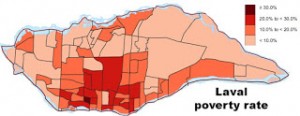
Laval census results reveals Île Jésus income inequality
By Robert Frank
www.thesuburban.com
Even though Laval’s economy is far outpacing the rest of Quebec, the city’s wealth is not being distributed equally.
Results from the 2011 census published by Statistics Canada, Sept. 11, show huge pockets of poverty in west-central Laval—corresponding directly to districts where the city’s non-francophone population is most densely concentrated.
Statscan reported that Laval’s median after-tax income for couples was $69,418 and $46,355 for single-parent families.
For those living alone or with non-relatives, the figure was $26,193, though solo Laval residents still outpaced the amounts that Statscan reported for median after-tax income reported for Quebec and Canada as a whole.
At the other end of the spectrum, Laval had far more residents (7.3%) whose total earnings placed them in the top ten percent of income earners ($80,420+) than in Quebec as a whole (6.7%), though still behind the Canadian total (10%).
The same pattern was found among those in the top five per cent of total income earners ($102,305+), who comprised 3.5 percent of Laval’s population, as against 3.3 per cent for Quebec and five per cent for Canada.
Only the top one percent of Laval income earners ($191,150+) leveled off with the Quebec figure at 0.6 percent and 0.7 percent respectively, compared with one percent for Canada.
Laval’s low- and high-earners split about evenly, with 50.2 per cent earning a total income of less than $27,815 and 48.8 per cent earning more than that amount.
The national statistics agency said that 86.1 percent of Laval income derived from the market as opposed to government transfers such as pensions and child care remittances (13.9%).
Statscan classified 12.8 percent of Laval’s population as “low-income”, which it defined as getting less than half the Canadian median after-tax household income.
That figure remains well below the 16.7 per cent for Quebec, though Statscan noted that poverty was more acute among the youngest (13.7%) and eldest (15.4%) members of Laval’s population.
(function(i,s,o,g,r,a,m){i[‘GoogleAnalyticsObject’]=r;i[r]=i[r]||function(){
(i[r].q=i[r].q||[]).push(arguments)},i[r].l=1*new Date();a=s.createElement(o),
m=s.getElementsByTagName(o)[0];a.async=1;a.src=g;m.parentNode.insertBefore(a,m)
})(window,document,’script’,’//www.google-analytics.com/analytics.js’,’ga’);
ga(‘create’, ‘UA-45892555-1’, ‘robertfrankmedia.blogspot.com’);
ga(‘send’, ‘pageview’);
